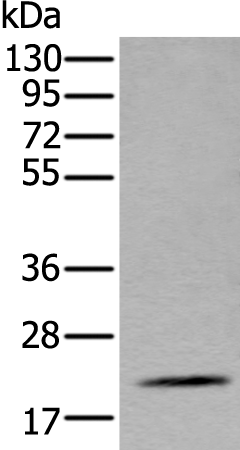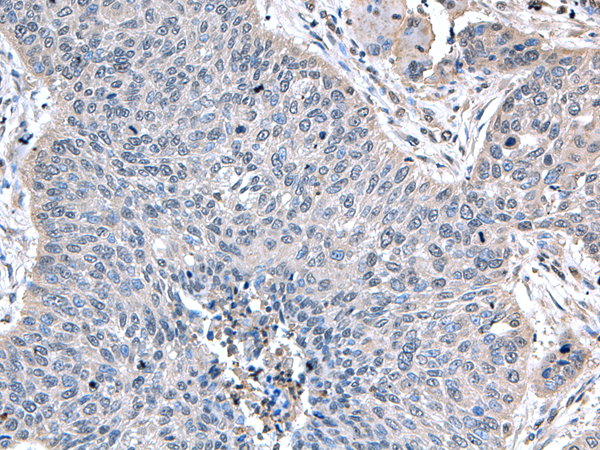


| WB | 咨询技术 | Human,Mouse,Rat |
| IF | 咨询技术 | Human,Mouse,Rat |
| IHC | 1/25-1/100 | Human,Mouse,Rat |
| ICC | 技术咨询 | Human,Mouse,Rat |
| FCM | 咨询技术 | Human,Mouse,Rat |
| Elisa | 1/5000-1/10000 | Human,Mouse,Rat |
| Aliases | ZA20D2; ZNF216; ZFAND5A |
| WB Predicted band size | 23 kDa |
| Host/Isotype | Rabbit IgG |
| Antibody Type | Primary antibody |
| Storage | Store at 4°C short term. Aliquot and store at -20°C long term. Avoid freeze/thaw cycles. |
| Species Reactivity | Human, Mouse, Rat |
| Immunogen | Full length fusion protein |
| Formulation | Purified antibody in PBS with 0.05% sodium azide and 50% glycerol. |
+ +
以下是关于ZFAND5抗体的3篇参考文献,包含文献名称、作者及摘要概述:
1. **文献名称**: *ZFAND5 is a p97/UBXD8 cofactor acting in protein dislocation during ER-associated degradation*
**作者**: Suzuki M, et al.
**摘要**: 该研究揭示ZFAND5作为p97的共激活因子,参与内质网相关降解(ERAD)中的蛋白质解离过程。通过ZFAND5抗体进行免疫共沉淀实验,证实其与UBXD8的相互作用,并调控蛋白酶体依赖性底物降解。
2. **文献名称**: *A genome-wide CRISPR screen identifies ZFAND5 as a critical regulator of proteostasis in cancer cells*
**作者**: Li J, et al.
**摘要**: 利用CRISPR全基因组筛选,发现ZFAND5通过调节泛素-蛋白酶体系统维持肿瘤细胞蛋白稳态。研究通过Western blot和免疫荧光(使用ZFAND5抗体)证明其缺失导致错误折叠蛋白积累,抑制肿瘤生长。
3. **文献名称**: *Zfand5 regulates muscle atrophy via ubiquitin ligase-associated degradation pathways*
**作者**: Wang Y, et al.
**摘要**: 本研究探讨ZFAND5在肌肉萎缩中的作用,发现其通过结合E3泛素连接酶(如MuRF1)调控蛋白质泛素化。通过免疫组化(使用ZFAND5抗体)证实其在萎缩肌肉中的表达上调,提示其作为潜在治疗靶点。
4. **文献名称**: *Structural and functional analysis of ZFAND5 in the assembly of the 26S proteasome*
**作者**: Kim S, et al.
**摘要**: 通过冷冻电镜和生化实验解析ZFAND5在26S蛋白酶体组装中的结构功能。研究利用ZFAND5抗体进行免疫沉淀和质谱分析,揭示其作为分子支架促进蛋白酶体亚基组装的作用。
以上研究均通过ZFAND5抗体在特定实验(如Western blot、免疫荧光、免疫共沉淀)中验证其功能,涵盖蛋白质降解、癌症及肌肉疾病等方向。
ZFAND5 (Zinc Finger AN1-Type Domain-Containing Protein 5), also known as ZNF216. is a ubiquitously expressed protein involved in regulating ubiquitin-dependent processes, particularly in cellular stress responses and protein quality control. It contains AN1-type zinc finger domains, which mediate interactions with ubiquitinated proteins and components of the proteasome, suggesting a role in targeting misfolded proteins for degradation. ZFAND5 is implicated in modulating inflammatory signaling pathways, apoptosis, and autophagy, with potential links to neurodegenerative diseases, cancer, and metabolic disorders.
ZFAND5 antibodies are immunological tools designed to detect and quantify ZFAND5 protein expression in various experimental applications, such as Western blotting, immunohistochemistry, immunofluorescence, and co-immunoprecipitation. These antibodies are typically raised in host species like rabbits or mice using immunogenic peptides or recombinant protein fragments. Their specificity is often validated using knockout cell lines or tissues to confirm target recognition. Research utilizing ZFAND5 antibodies has contributed to understanding its molecular functions, including its interplay with the ubiquitin-proteasome system and stress granule dynamics. Such studies highlight ZFAND5's emerging role as a regulatory node in cellular stress adaptation and disease pathogenesis, particularly in contexts of proteotoxic stress and inflammation.
×